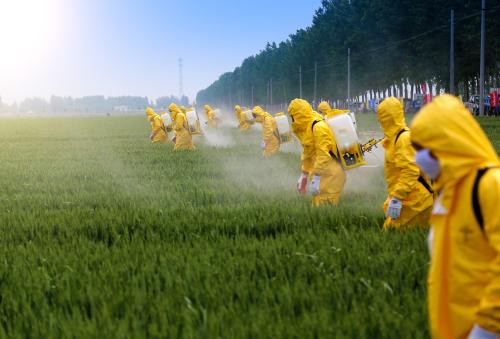This analysis is part of the USC-Brookings Schaeffer Initiative for Health Policy, which is a partnership between Economic Studies at Brookings and the University of Southern California Schaeffer Center for Health Policy & Economics. The Initiative aims to inform the national health care debate with rigorous, evidence-based analysis leading to practical recommendations using the collaborative strengths of USC and Brookings. We gratefully acknowledge financial support from Arnold Ventures.
The COVID pandemic has disrupted supply chains across the economy. Disruptions have been particularly acute in the health sphere, with COVID tests, vaccines, and treatments in short supply at various points in the pandemic. But as the baby formula crisis has reminded us, shortages of critical products impacting health are not just tied to pandemics. In this case, the shortage was caused by a shutdown of a key manufacturing facility, following evidence of bacterial contamination in products made at the facility. This facility produced a large share of specific baby formula types, creating a shortfall that could not be made up by other manufacturers.
Demand and supply shocks like the ones described above can and do happen. But those shocks need not turn into shortages if the supply chain for the product is resilient. It is incumbent upon companies and regulators to assess vulnerabilities of specific supply chains, before developing risk mitigation plans, strategically ramping up regulatory oversight, and providing targeted interventions such as requirements or support for redundancy, technology improvements, stockpiling, or sourcing from more reliable (and likely more costly) suppliers.
Developing a list of critically important products is a starting point for such efforts. For that reason, what products are on the list matters. We propose that such a list should be somewhat different than what the Food and Drug Administration (FDA) created in 2021 and should include products such as baby formula, common inactive drug ingredients, and drugs such as antipsychotics.
The 2021 Essential Medicines, Medical Countermeasures and Critical Inputs list was created by the FDA in response to President Trump’s August 2020 Executive Order. The order directed the FDA to develop a list in face of “outbreaks of emerging infectious diseases and chemical, biological, radiological, and nuclear (CBRN) threats.” President Biden took the supply chain resilience efforts further by issuing a February 2021 Executive Order directing assessments of critical supply chains for vulnerability, taking a somewhat broader view to include “extreme weather events, terrorist attacks, geopolitical and economic competition, and other conditions.” For the U.S. Department of Health and Human Services (HHS), the starting point for these assessments was the existing FDA list.
A list of products needed in response to a public health crisis is different than a list of products without which we will have a public health crisis.
But this starting point falls short of the mark, as the baby formula shortage illustrates. The shortage highlights how recent approaches to defining supply chain problems distort solutions and in turn fail to address the scope of the public health ramifications of supply interruptions. The nation will remain unprepared for crises if we narrowly define products essential to health to only those that are used in response to infectious diseases and chemical, biological, radiological, and nuclear threats.
Updating the list is also important because, in addition to baby formula, there are many other products without which a public health crisis would ensue. A 2022 National Academies report provides a useful framework for selecting products for resilience building initiatives. It considers three elements: the expected harm that a given product user might suffer from a shortage, the magnitude of a potential shortage, and the risk that a product may go into shortage. The first two elements are what we would consider for updating the list, with the third criterion assessed through an analysis of vulnerability.
In line with this framework, a list aimed at preventing supply disruptions from becoming public health crises would also likely consider not just individual products like baby formula, but also inactive ingredients used in drugs (also known as excipients). According to the NIH DailyMed, 26,709 drug products include Microcrystalline cellulose and 33,461 include Magnesium Stearate. And these are only two of many inactive ingredients that are used commonly in oral dose product formulations. A severe shortage in the supply of any such common ingredients could potentially affect dozens of millions of patients, so it would be important to understand the risk of such disruptions and engage in risk management if needed.
We also propose that in updating the list, policy makers consider impacts that extend beyond product users. There are a variety of products that—if they become unavailable—would have significant social and public health consequences. Take the case of key psychotropic medications (like antipsychotic agents and mood stabilizers). If the availability of such drugs is interrupted, people with severe mental illnesses would likely become less stable, potentially impacting communities through increases in disturbing behavior, homelessness, suicide, victimization, and, in some cases, violence.
But why add baby formula to this list? After all, Congress is taking steps to assess the resilience of the baby food supply chain and enhancing FDA oversight. Even with the proposed creation of the FDA Office of Critical Foods, including baby formula on the essential product list would be beneficial because it would connect that office closer to the cross-government supply resilience efforts undertaken in response to the February 2021 Executive Order.
The existing essential product list was created by an executive order, so a follow-on executive order could work well in present day. Congress is also in position to direct the FDA to create such a list. But whatever the mechanism, it is important that the creation of this list does not fall solely to the FDA, but rather be a coordinated cross-agency effort, with input from other agencies and potentially departments.
The Brookings Institution is financed through the support of a diverse array of foundations, corporations, governments, individuals, as well as an endowment. A list of donors can be found in our annual reports published online here. The findings, interpretations, and conclusions in this report are solely those of its author(s) and are not influenced by any donation.
-
Acknowledgements and disclosures
We are grateful to Lauren Bauer for many helpful suggestions on an earlier draft of this paper.



Commentary
To prevent public health crises, we need to update the essential medical product list
June 24, 2022